1996 CADILLAC SEVILLE suspension
[x] Cancel search: suspensionPage 10 of 354
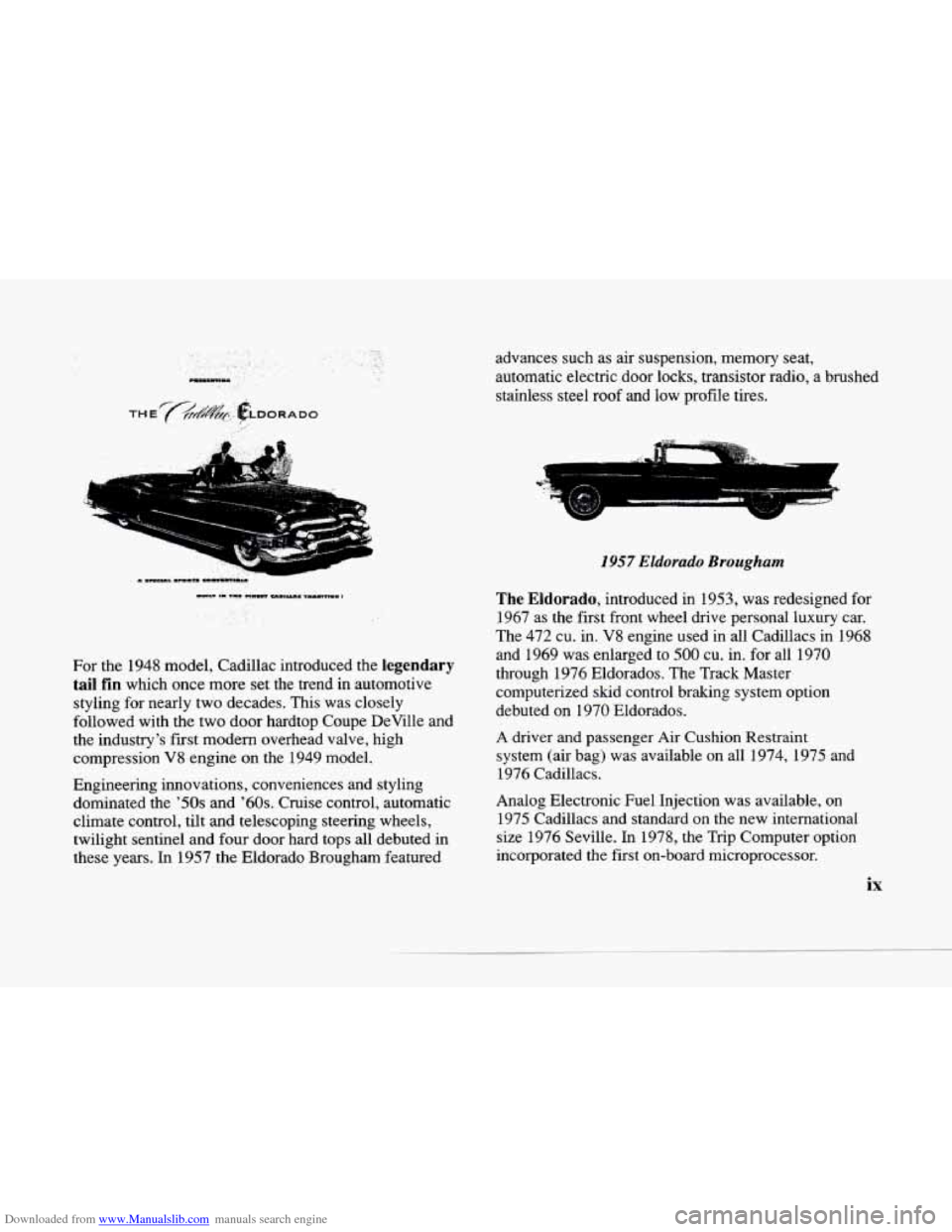
Downloaded from www.Manualslib.com manuals search engine c . . .- . '.
For the 1948 model, Cadillac introduced the legendary
tail fin which once more set the trend in automotive
styling for nearly two decades. This was closely
followed with the two door hardtop Coupe DeVille and
the industry's
first modern overhead valve, high
compression
V8 engine on the 1949 model.
Engineering innovations, conveniences and styling
dominated the
'50s and '60s. Cruise control, automatic
climate control, tilt and telescoping steering wheels,
twilight sentinel and four door hard tops all debuted in
these years. In 1957 the Eldorado Brougham featured advances such
as air suspension,
memory seat,
automatic electric door locks, transistor radio, a brushed
stainless steel roof and low profile tires.
7
1957 Eldorado Brougham
The Eldorado, introduced in 1953, was redesigned for
1967 as the first front wheel drive personal luxury
car.
The 472 cu. in. V8 engine used in all Cadillacs in 1968
and 1969 was enlarged to
500 cu. in. for all 1970
through 1976 Eldorados. The Track Master
computerized skid control braking system option
debuted on 1970 Eldorados.
A driver and passenger Air Cushion Restraint
system (air bag) was available
on all 1974, 1975 and
1976 Cadillacs.
Analog Electronic Fuel Injection was available, on
1975 Cadillacs and standard
on the new international
size 1976 Seville. In 1978, the Trip Computer option
incorporated the first on-board microprocessor.
ix
Page 11 of 354
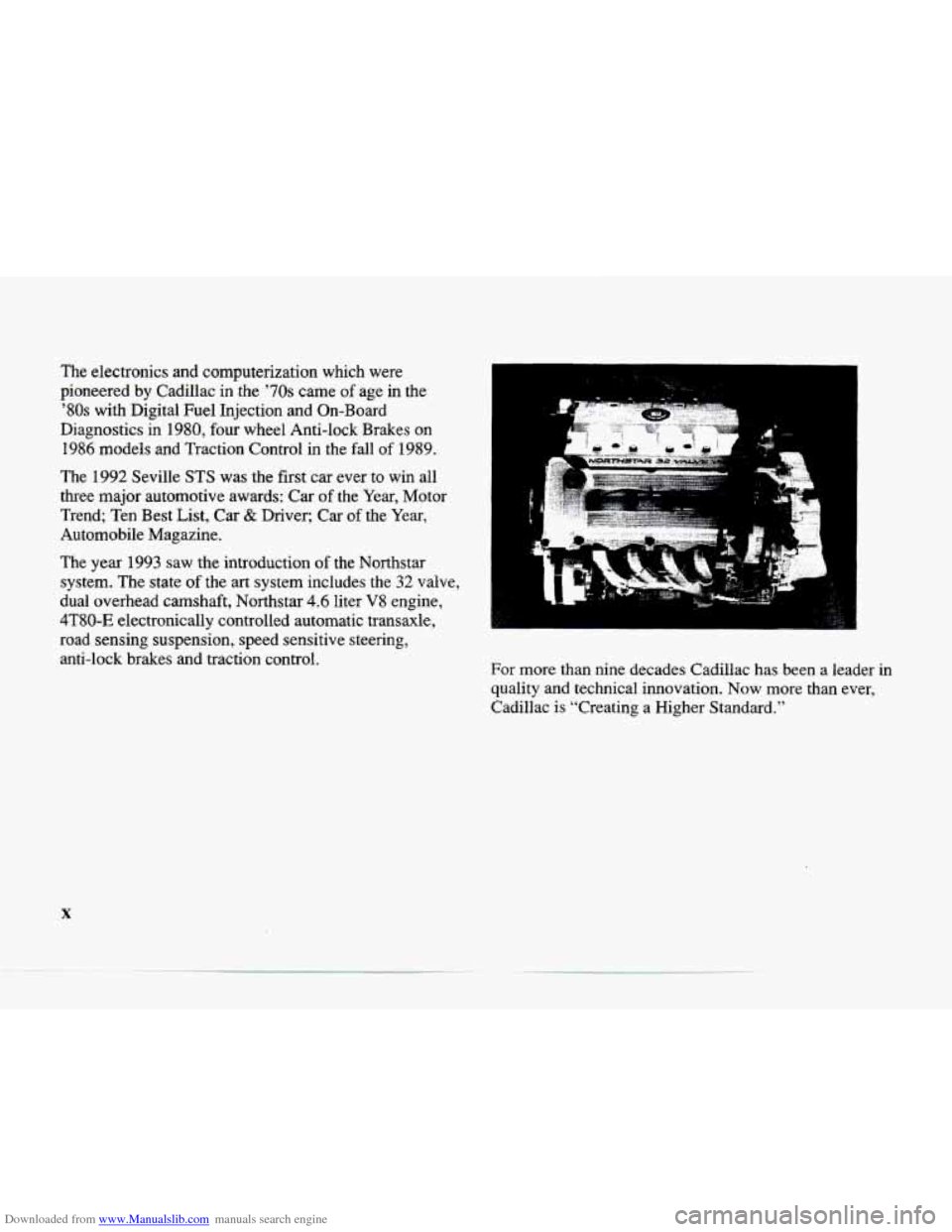
Downloaded from www.Manualslib.com manuals search engine The electronics and computerization which were
pioneered by Cadillac in the
’70s came of age in the
’80s with Digital Fuel Injection and On-Board
Diagnostics
in 1980, four wheel Anti-lock Brakes on
1986 models and Traction Control in the fall of 1989.
The 1992 Seville
STS was the first car ever to win all
three major automotive awards: Car
of the Year, Motor
Trend; Ten Best List,
Car & Driver; Car of the Year,
Automobile Magazine.
. .. . .. . .. .I,..,,. ~ :;- ~ .,.,........ .... .. . ,,.._ ._
.. . , , . . . .. . . . .:: ..iliiii-’ ... ... .,. . . . .. . . ... . . . .. , . ., ,
The year 1993 saw the introduction of the Northstar
system. The state
of the art system includes the 32 valve,
dual overhead camshaft, Northstar
4.6 liter V8 engine,
4TSO-E electronically controlled automatic transaxle,
road sensing suspension, speed sensitive steering,
anti-lock brakes and traction control. For more than
nine decades Cadillac has been a leader in
quality and technical innovation.
Now more than ever,
Cadillac is “Creating a Higher Standard.”
X
Page 143 of 354

Downloaded from www.Manualslib.com manuals search engine SERVICE AIR BAG - 83: There is a problem with the
Supplemental Inflatable Restraint (air bag) system when
this message appears. Let only a qualified technician
work on your vehicle. See your Cadillac dealership for
service
at once.
SERVICE BRAKE FLUID SWITCH - 37: A high
level
of brake fluid causes this message to display if the
ignition is
in the RUN position. Have the brake system
serviced by a Cadillac technician as soon as possible.
If
the brake warning light is on, refer to the directions
listed in that part.
SERVICE CHARGING SYSTEM - 102: This
message will display when a problem with the charging
system has been detected. Have your vehicle serviced at
your Cadillac dealership.
SERVICE ELECTRICAL SYSTEM - 106: This
message will display
if an electrical problem has
occurred within the PCM. Have
your vehicle service by
your Cadillac dealership.
SERVICE EMISSIONS SYSTEM - 104: A problem
in the emissions system has occurred when thts message
appears. Have your Cadillac dealership service your vehicle.
SERVICE ENGINE COOLING SYSTEM - 103: A
problem within the engine cooling system has been
detected when this message displays. See your Cadillac
dealership
for service.
SERVICE FUEL SYSTEM - 101: The PCM
has detected a problem within the fuel system when
this message appears. See your Cadillac dealership
for service.
SERVICE IDLE CONTROL SYSTEM - 107: A
problem with the idle control has occurred when this
message displays. Bring your vehicle
to your Cadillac
dealership for service.
SERVICE IGNITION SYSTEM - 105: This message
displays when a failure in the ignition system has been
detected. Have your vehicle serviced
by your Cadillac
dealership.
SERVICE RIDE CONTROL - 84: This message is
displayed to indicate that the suspension system is not
operating properly.
To correct this problem have your
vehicle serviced at your Cadillac dealership.
SERVICE TRANSMISSION - 100: If a problem is
detected with the transaxle,'this message will appear.
Have
your vehicle checked by your Cadillac dealership.
2-84
Page 145 of 354
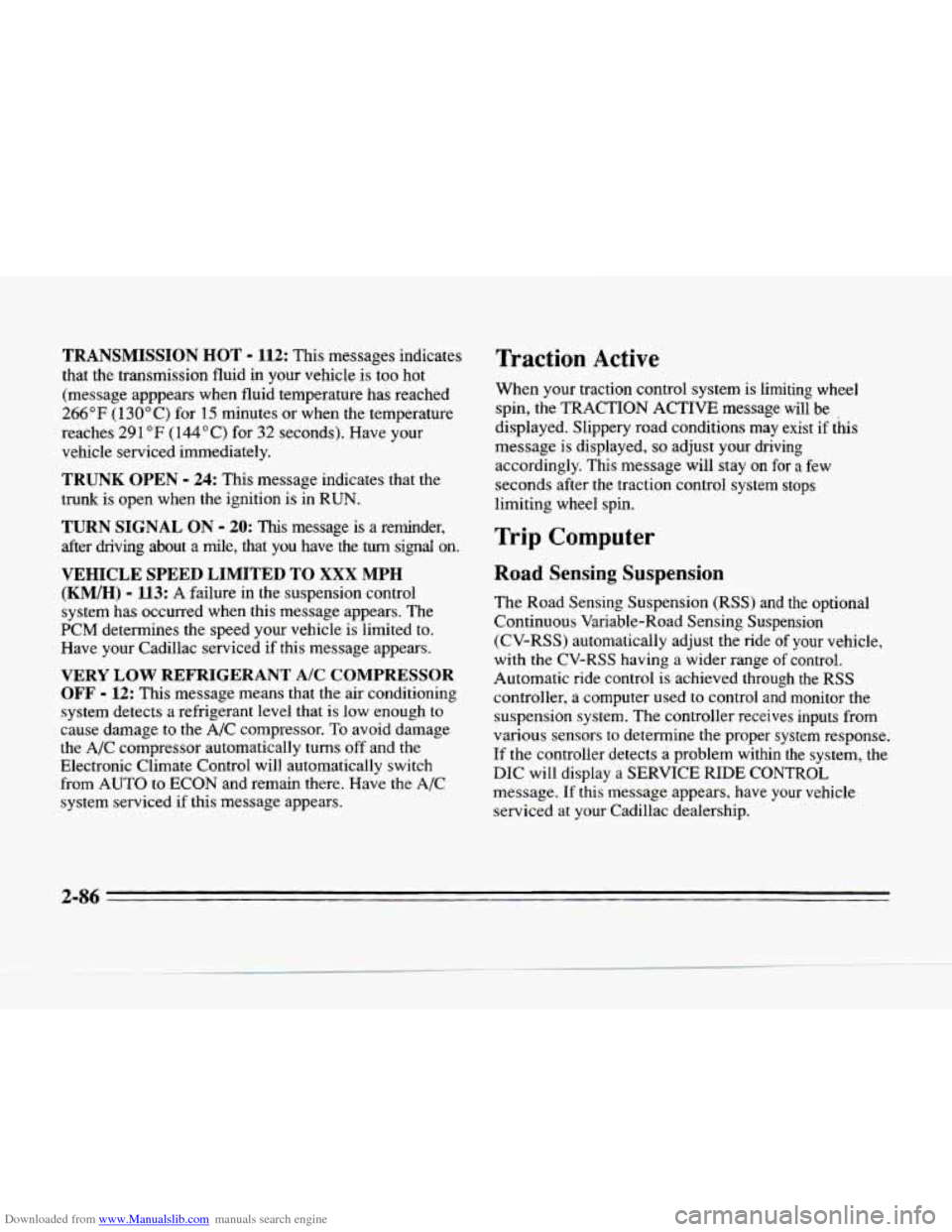
Downloaded from www.Manualslib.com manuals search engine TRANSMISSION HOT - 112: This messages indicates
that the transmission fluid in your vehicle is too hot
(message apppears when fluid temperature has reached
266°F (1 30°C) for 15 minutes or when the temperature
reaches
291 OF (144°C) for 32 seconds). Have your
vehicle serviced immediately.
TRUNK OPEN - 24: This message indicates that the
trunk
is open when the ignition is in RUN.
TURN SIGNAL ON - 20: This message is a reminder,
after driving about
a mile, that you have the turn signal on.
VEHICLE SPEED LIMITED TO XXX MPH
(KM/H) - 113: A failure in the suspension control
system has occurred when this message appears. The
PCM determines the speed your vehicle is limited to.
Have your Cadillac serviced if this message appears.
VERY LOW REFRIGERANT A/C COMPRESSOR
OFF - 12: This message means that the air conditioning
system detects a refrigerant level that is
low enough to
cause damage to
the A/C compressor. To avoid damage
the
A/C compressor automatically turns off and the
Electronic Climate Control will automatically switch
from
AUTO to ECON and remain there. Have the A/C
system serviced if this message appears.
Traction Active
When your traction control system is limiting wheel
spin, the TRACTION ACTIVE message will be
displayed. SIippery road conditions may exist
if this
message is displayed,
so adjust your driving
accordingly. This message will stay
on for a few
seconds after the traction control system stops
limiting wheel spin.
Trip Computer
Road Sensing Suspension
The Road Sensing Suspension (RSS) and the optional
Continuous Variable-Road Sensing Suspension
(CV-RSS) automatically adjust the ride
of your vehicle,
with the CV-RSS having
a wider range of control.
Automatic ride control is achieved through the
RSS
controller, a computer used to control and monitor the
suspension system. The controller receives inputs from
various sensors
to determine the proper system response.
If the controller detects a problem
within the system, the
DIC will display
a SERVICE RIDE CONTROL
message. If this message appears, have your vehicle
serviced at your Cadillac dealership.
2-86
Page 231 of 354
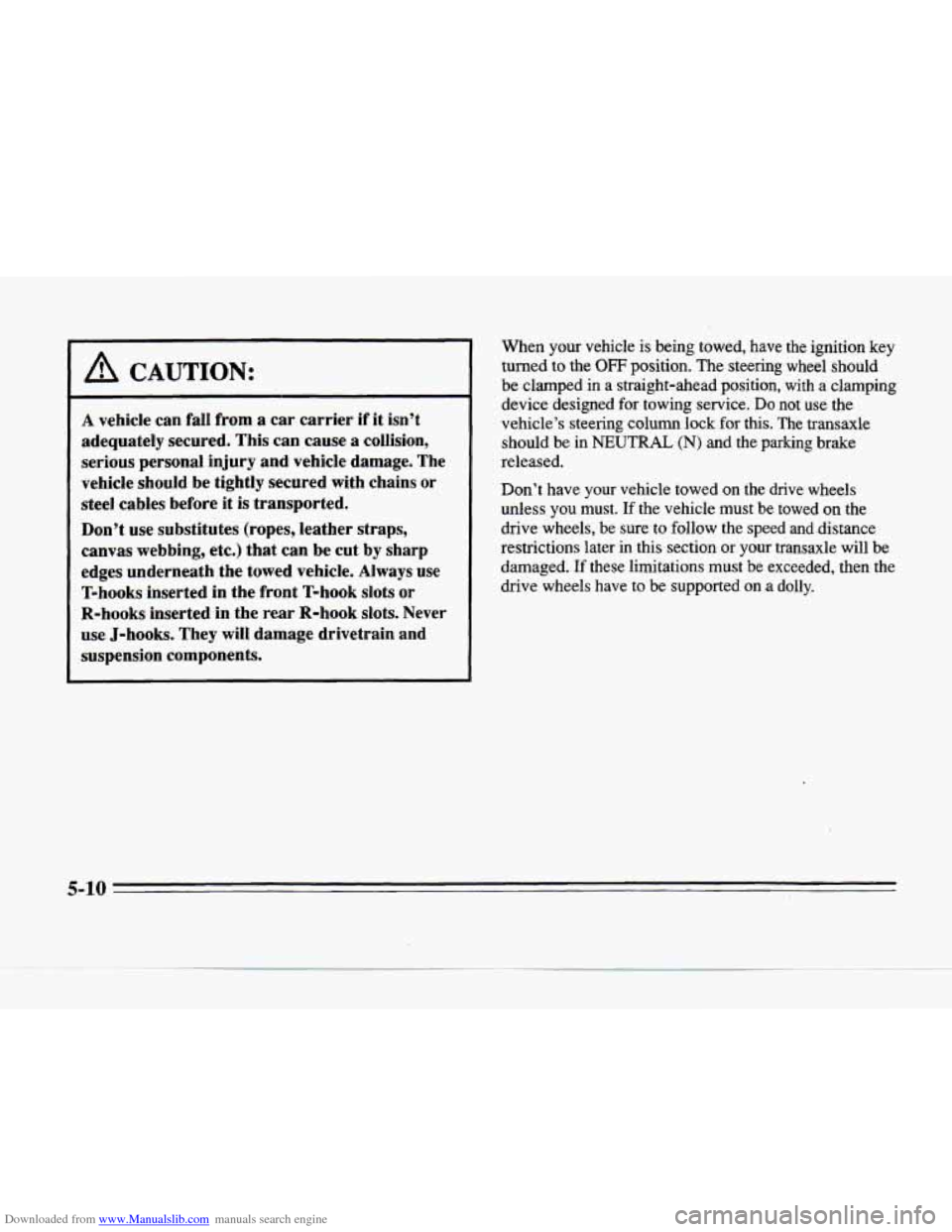
Downloaded from www.Manualslib.com manuals search engine ~ A CAUTION:
A vehicle
can fa11 from a car carrier if it isn’t
adequately secured. This can cause a collision,
serious personal injury and vehicle damage. The
vehicle should be tightly secured with chains
or
steel cables before it is transported.
Don’t use substitutes (ropes, leather straps,
canvas webbing, etc.) that can
be cut by sharp
edges underneath the towed vehicle. Always use
T-hooks inserted in
the front T-hook slots or
R-hooks inserted in the rear R-hook slots. Never
use J-hooks. They will damage drivetrain
and
suspension components. When
your vehicle is being towed, have the ignition key
turned to the
OFF position. The steering wheel should
be clamped in a straight-ahead position, with a clamping
device designed for towing service.
Do not use the
vehicle’s steering column lock
for this. The transaxle
should
be in NEUTRAL (N) and the parking brake
released.
Don’t have your vehicle towed on the drive wheels
unless you must. If the vehicle must be towed on the
drive wheels, be sure to follow the speed
and .distance
restrictions later
in this section or your transaxle will be
damaged. If these limitations
must be exceeded, then the
drive wheels have to be supported on
a dolly.
Page 232 of 354
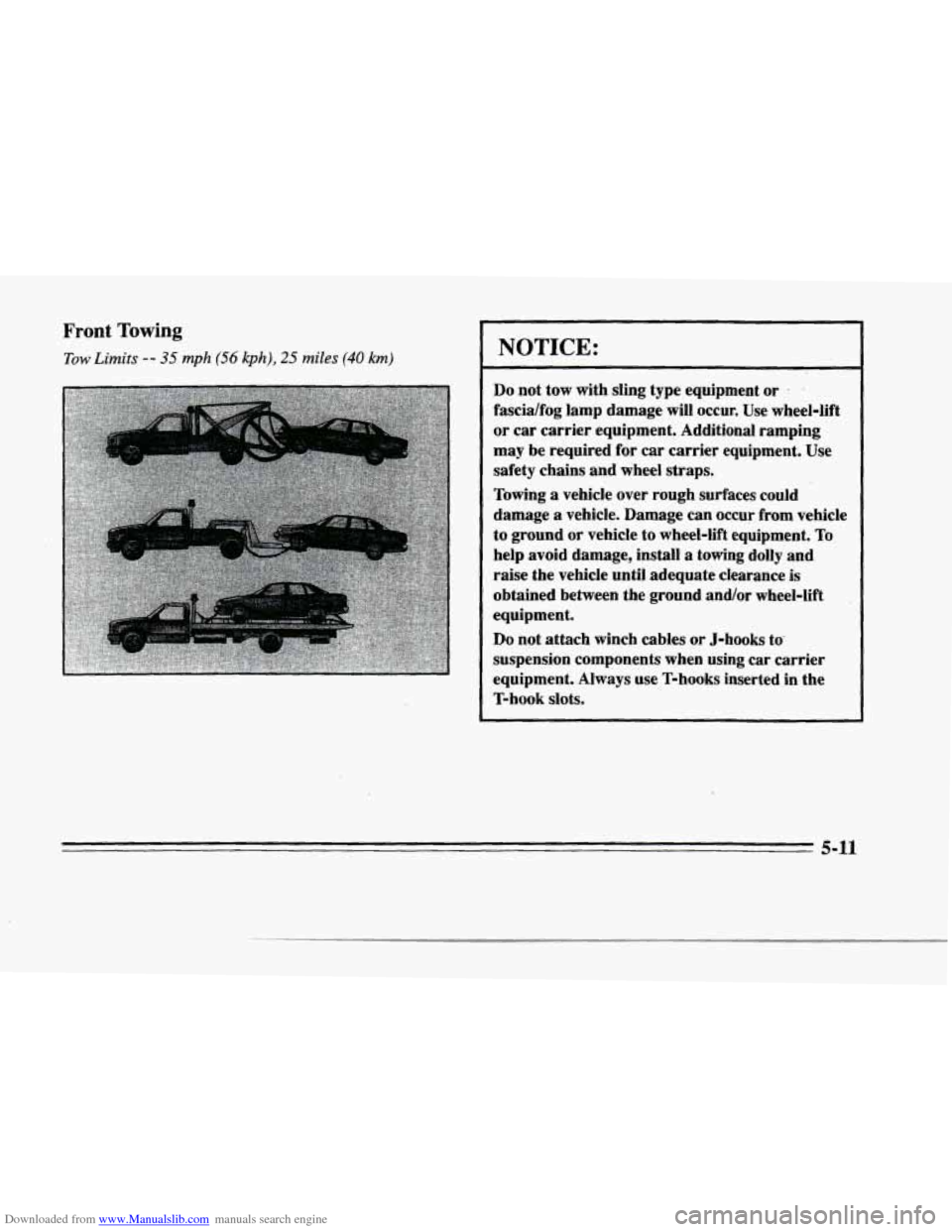
Downloaded from www.Manualslib.com manuals search engine r Front Towing
Tow Limits -- 35 mph (56 kph), 25 miles (40 km)
f
t
p"
I
i
f
NOTICE:
Do not tow with sling type equipment or - .
fascidfog lamp damage will occur. Use wheel-lift
or car carrier equipment. Additional ramping
may be required for car
carrier equipment. Use
safety chains and wheel straps.
Towing
a vehicle over rough surfaces could
damage
a vehicle. Damage can occur from vehicle
to ground
or vehicle to wheel-lift equipment. To
help avoid damage, install a towing dolly and
raise the vehicle until adequate clearance
is
obtained between the ground andlor wheel-lift
equipment.
Do not attach winch cables or J-hooks to'
suspension components when using
car carrier
equipment. Always use T-hooks inserted in the
T-hook Slots.
..
5-11
Page 234 of 354
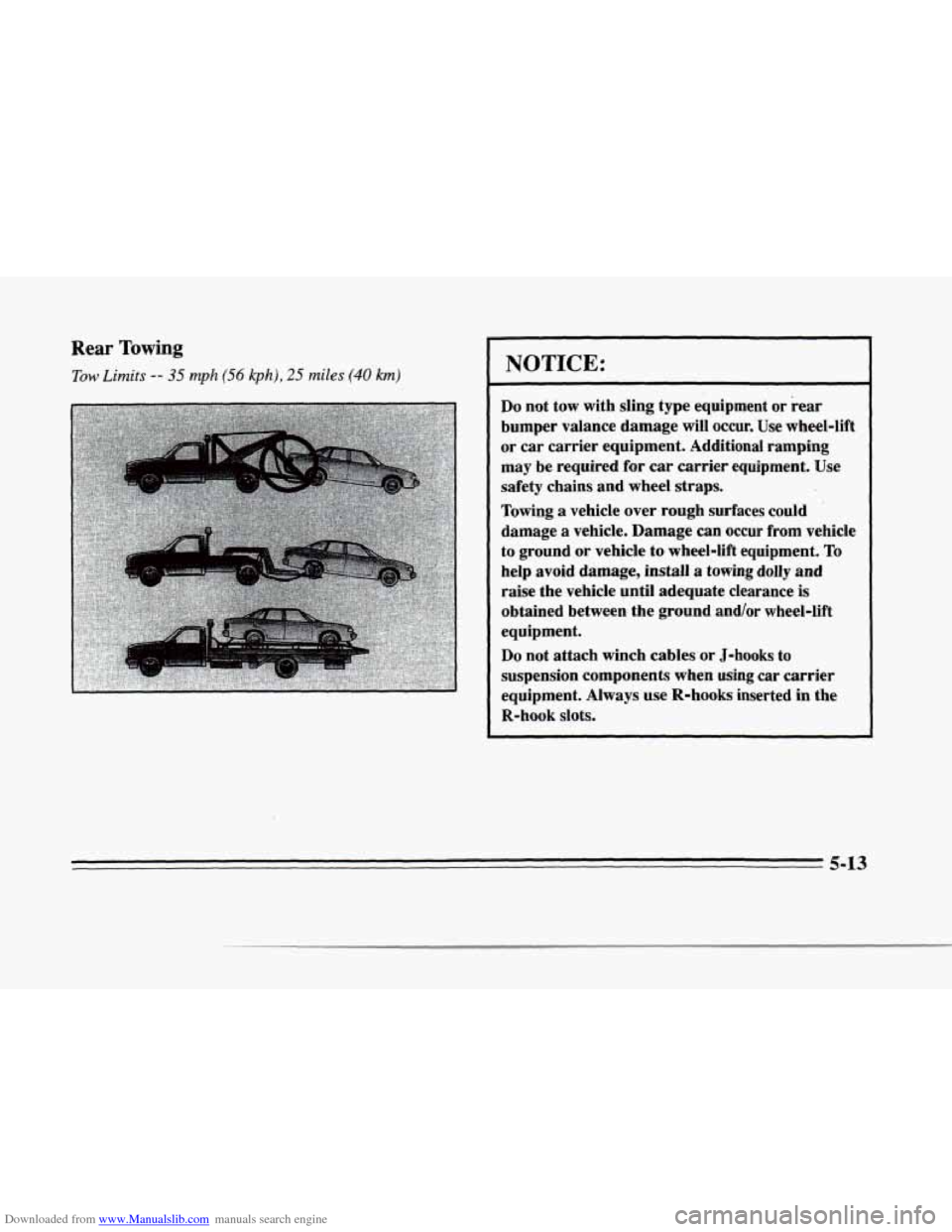
Downloaded from www.Manualslib.com manuals search engine P
f .-
?- I /
Rear Towing
Tow Limits -- 35 mph (56 kph), 25 miles (40 km) NOTICE:
Do not tow with sling type equipment or rear
bumper valance damage will occur. Use wheel-lift
or car carrier equipment. Additional ramping
may be required for car carrier equipment. Use
safety chains and wheel straps.
Towing
a vehicle over rough surfaces could
damage
a vehicle. Damage can occur from vehicle
to ground or vehicle
to wheel-lift equipment. To
help avoid damage, install a towing dolly and
raise the vehicle until adequate clearance
is
obtained between. the ground and/or wheel-lift
equipment.
Do not attach winch cables'or J-hooks to
suspension components when using car carrier
equipment. Always use R-hooks inserted in the
R-hook slots.
5-13
Page 349 of 354
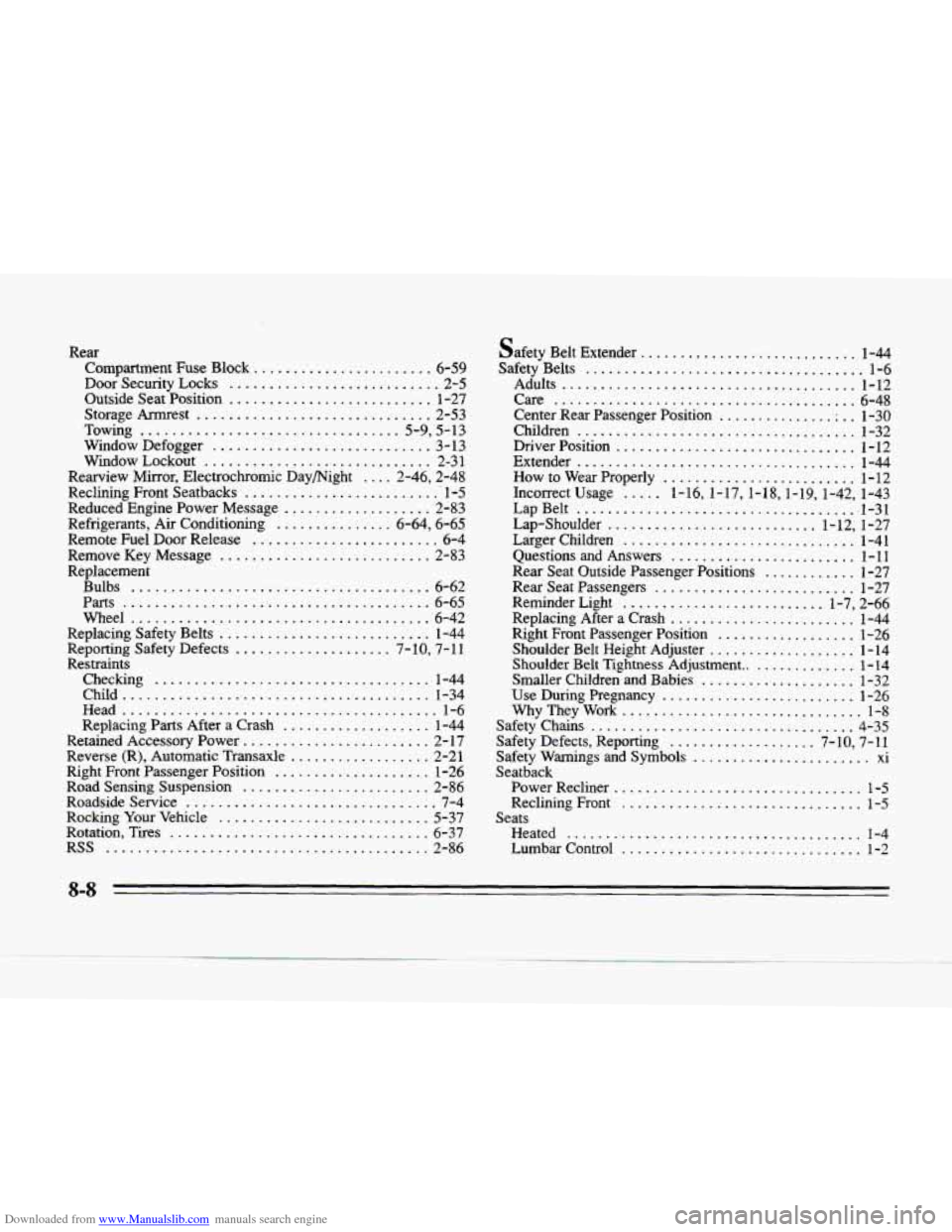
Downloaded from www.Manualslib.com manuals search engine Rear Compartment Fuse Block ....................... 6-59
Outside Seat Position .......................... 1-27
Storage Armrest
.............................. 2-53
Window Defogger
............................ 3- 13
Window Lockout
............................. 2-31
Reduced Engine Power Message
................... 2-83
Refrigerants, Air Conditioning
............... 6-64, 6-65
Remote Fuel Door Release
........................ 6-4
Remove Key Message
........................... 2-83
DoorSecurityLocks
........................... 2-5
Towing
................................. 5-9, 5-13
Rearview Mirror, Electrochromic Daymight
.... 2-46, 2-48
Reclining Front Seatbacks
.......................... 1-5
Replacement Bulbs
...................................... 6-62
Parts
....................................... 6-65
Wheel
...................................... 6-42
Replacing Safety Belts ........................... 1-44
Reporting Safety Defects
.................... 7-10, 7-11
Restraints Checking
................................... 1-44
Child
....................................... 1-34
Head
.,..................................... l-6
Replacing Parts After a Crash ................... 1-44
Retained Accessory Power
........................ 2-17
Reverse (R), Automatic Transaxle
.................. 2-21
Right Front Passenger Position
.................... 1-26
Road Sensing Suspension
........................ 2-86
Roadside Service
................................ 7-4
Rocking
Your Vehicle ........................... 5-37
Rotation, Tires
................................. 6-37
RSS
......................................... 2-86 Safety
Belt Extender
............................ 1-44
Safety Belts
.................................... 1-6
Adults
...................................... 1-12
Care
....................................... 6-48
Center Rear Passenger Position
............... : .. 1-30
Children
.................................... l-32
Driver Position ............................... 1-12
Extender
.................................... 1-44
How to Wear Properly
......................... 1-12
Incorrect Usage
..... 1-16, 1-17, 1-18,l-19, 1-42, 1-43
Lap Belt
...................................... 1-31
Lap-Shoulder
........................... 1-12, 1-27
Larger Children
.............................. 1-41
Questions
and Answers ........................ 1-11
Rear Seat Outside Passenger Positions
............ 1-27
Rear Seat Passengers
.......................... 1-27
Reminder Light
.......................... 1-7, 2-66
Replacing After
a Crash ........................ 1-44
Right Front Passenger Position
.................. 1-26
Shoulder Belt Height Adjuster
................... 1-14
Shoulder Belt Tightness Adjustment
............... 1-14
Smaller Children and Babies
.................... 1-32
Use During Pregnancy ......................... 1-26
Safety Chains
.................................. 4-35
Safety Defects, Reporting
................... 7-10, 7-11
Safety Warnings
and Symbols ....................... xi
Power Recliner ................................ 1-5
Reclining Front
............................... 1-5
Lumbar Control
............................... 1-2
WhyTheyWork
............................... 1-8
Seatback
Seats Heated
...................................... 1-4
8-8